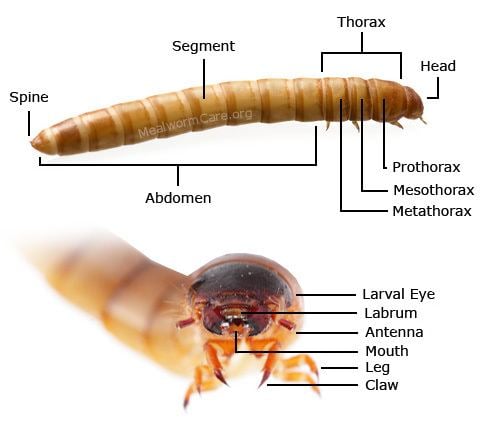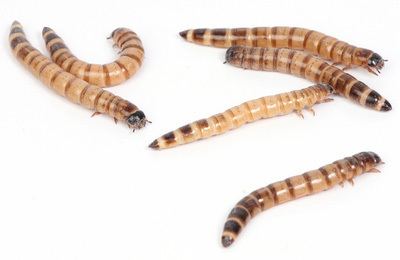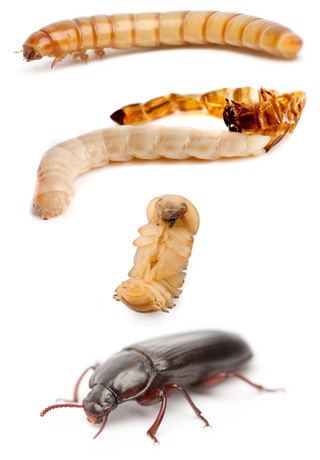Order Coleoptera Genus Tenebrio Rank Species | Family Tenebrionidae Scientific name Tenebrio molitor Higher classification Mealworm Beetle | |
 | ||
Similar Insect, Superworm, Cricket, Mealworm Beetle, Darkling beetle | ||
Easy way to breed insects mealworms
Mealworms are the larval form of the mealworm beetle, Tenebrio molitor, a species of darkling beetle. Like all holometabolic insects, they go through four life stages: egg, larva, pupa, and adult. Larvae typically measure about 2.5 cm or more, whereas adults are generally between 1.25 and 1.8 cm in length.
Contents
- Easy way to breed insects mealworms
- The edible insect cooking eating mealworms
- Reproduction
- Sex pheromones
- Relationship with humans
- As pests
- As food
- In waste disposal
- References
The edible insect cooking eating mealworms
Reproduction

The mealworm beetle breeds prolifically. Mating is a three-step process: the male chasing the female, mounting her and inserting his aedeagus, and injecting a sperm packet. Within a few days the female burrows into soft ground and lays about 500 eggs.
After four to 19 days the eggs hatch. Many predators target the eggs, including reptiles.

During the larval stage, the mealworm feeds on vegetation and dead insects and periodically molts. A molting episode occurs between each larval stage, or instar. The larva of this species has 9 to 20 instars. After the final one it becomes a pupa. The new pupa is whitish, and it turns brown over time. After 3 to 30 days, depending on environmental conditions such as temperature, it emerges as an adult beetle.
Sex pheromones

A sex pheromone released by male mealworms has been identified. Inbreeding reduces the attractiveness of sexual pheromone signaling by male mealworms. Females are more attracted to the odors produced by outbred males than the odors produced by inbred males. The reduction of male signaling capability may be due to increased expression of homozygous deleterious recessive alleles caused by inbreeding.
Relationship with humans
Tenebrio molitor is often used for biological research. Its relatively large size, ease of rearing and handling, and status as a non-model organism make it useful in proof of concept studies in the fields of basic biology, biochemistry, evolution, immunology and physiology.
As pests

Mealworms have generally been considered pests, because their larvae feed on stored grains. Mealworms probably originated in the Mediterranean region, but are now present in many areas of the world, spread by human trade and colonization. The oldest archaeological records of mealworms as human pests can be traced to Bronze Age Turkey. Records from the British Isles and northern Europe are from a later date, and mealworms are conspicuously absent from archaeological finds from ancient Egypt.
As food

Mealworms are edible for humans. Baked or fried mealworms are marketed as a healthful snack food. They may be easily reared on fresh oats, wheat bran or grain, with sliced potato, carrots, or apple as a moisture source.

Mealworms have been incorporated into tequila-flavored novelty candies. Mealworms are not traditionally served in tequila, and the "tequila worm" in certain mezcals is usually the larva of the moth Hypopta agavis.
Mealworms are typically used as a pet food for captive reptiles, fish, and birds. They are also provided to wild birds in bird feeders, particularly during the nesting season. Mealworms are useful for their high protein content. They are also used as fishing bait.
They are commercially available in bulk and are sold in containers of bran or oatmeal. Commercial growers incorporate a juvenile hormone into the feeding process to keep the mealworm in the larval stage and achieve an abnormal length of 2 cm or greater.
In waste disposal
In 2015, it was discovered that mealworms are capable of degrading polystyrene into usable organic matter at a rate of about 34-39 milligrams per day. Additionally, no difference was found between mealworms fed only styrofoam and mealworms fed conventional foods, during the one month duration of the experiment. The mechanism behind this is currently unknown, and no attempts to commercialize this discovery have been made.
